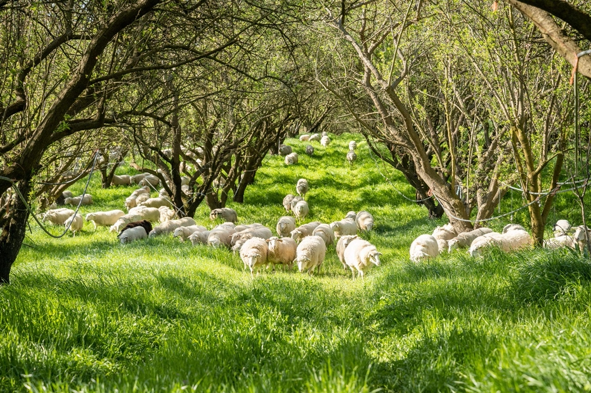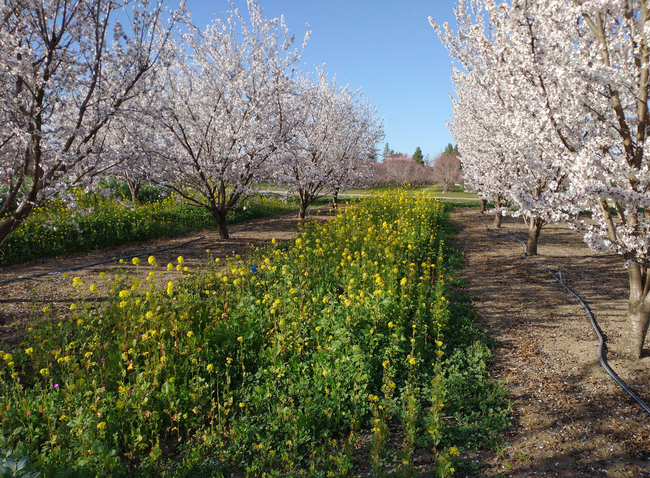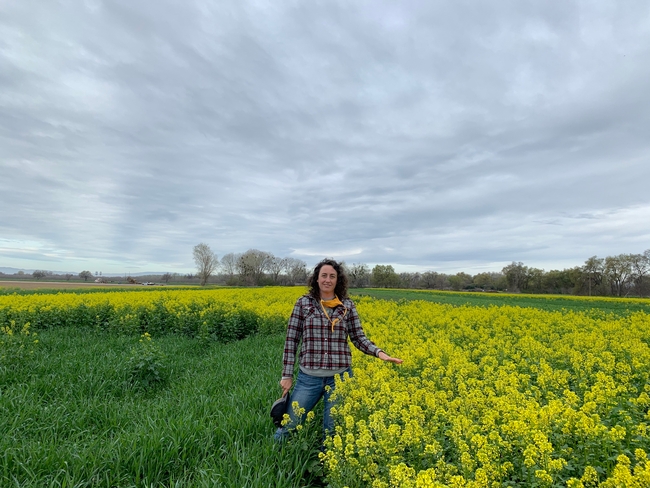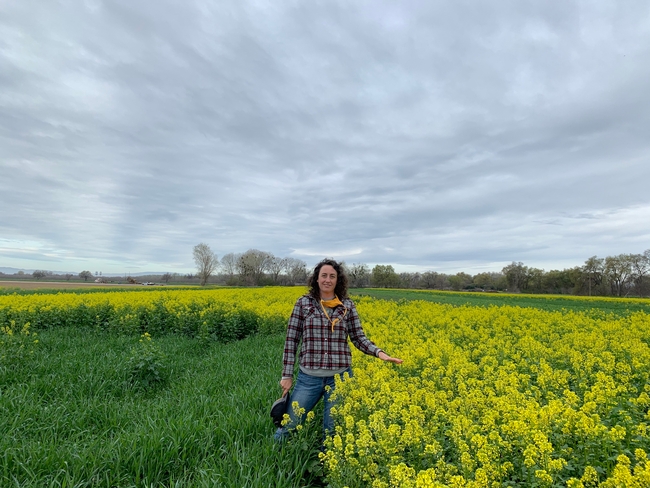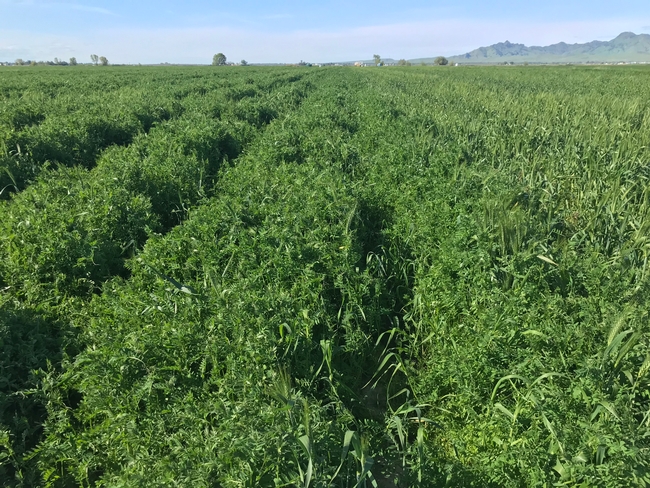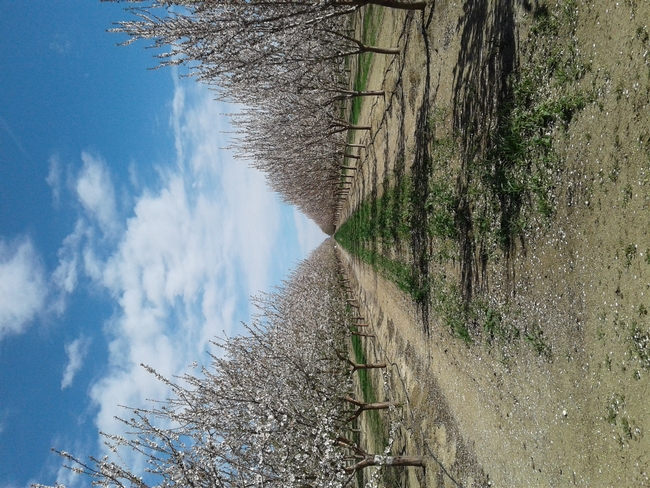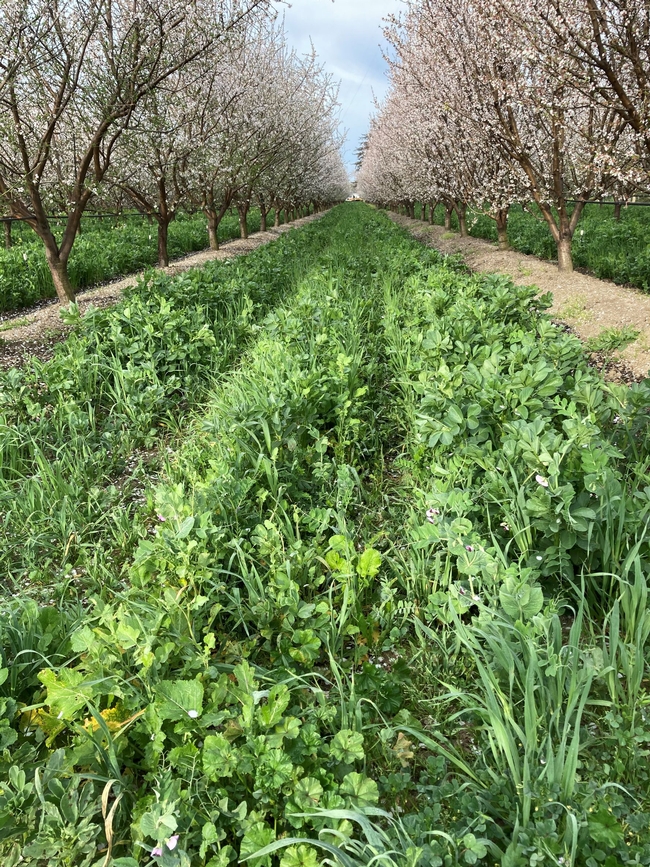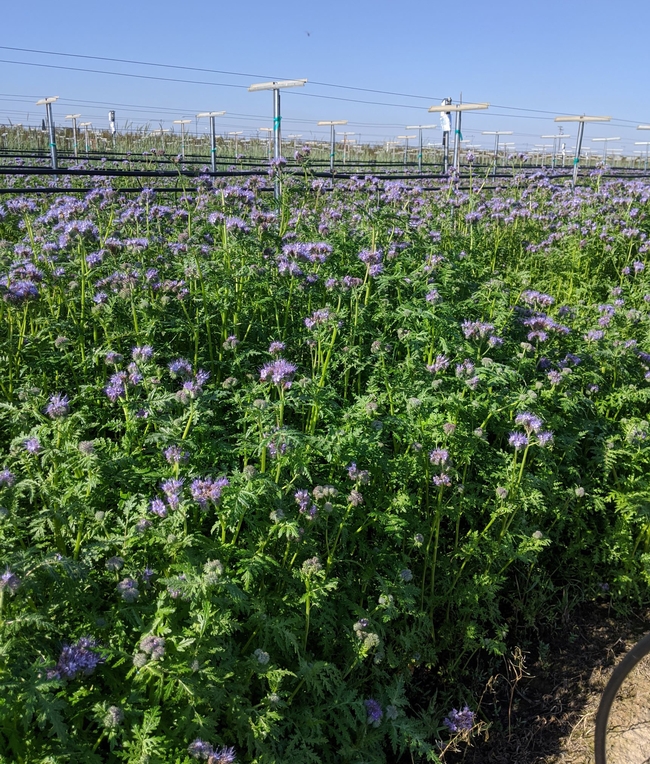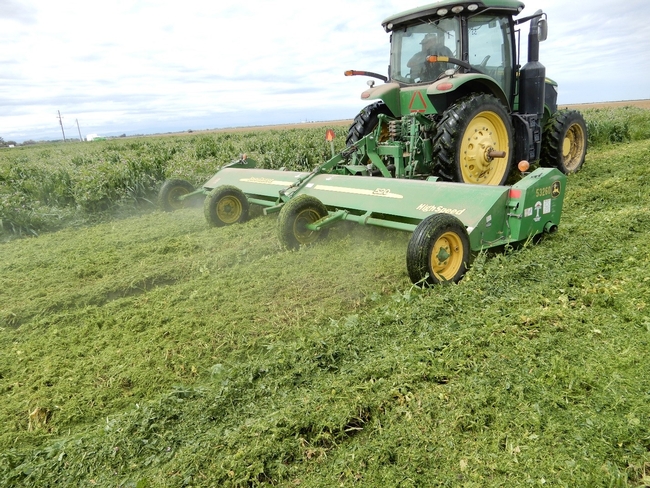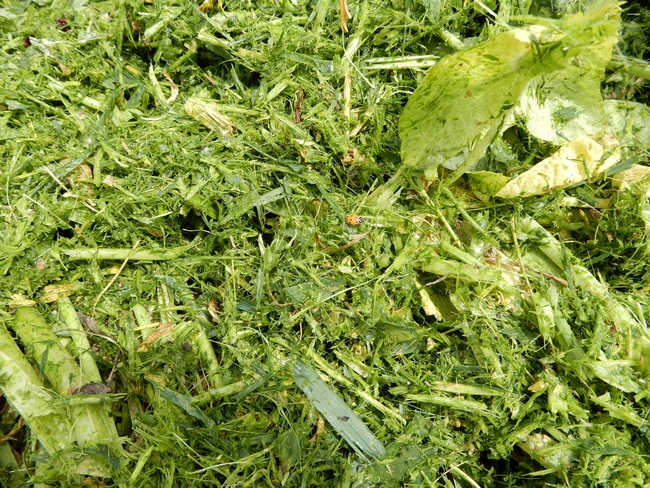Posts Tagged: cover crops
Growers invited to see benefits of cover crops in orchards, vineyards
Searchable database of growers experienced in growing cover crops launched
Growers are invited to tour orchards and vineyards and hear from other growers about their experiences with cover crops.
UC Sustainable Agriculture Research and Education Program, UC Cooperative Extension, the Napa Resource Conservation District, and the Community Alliance with Family Farmers have created a searchable database of orchard and vineyard growers experienced in growing cover crops that will help other growers bring the benefits of the practice to their operations.
“The tours are part of a project for which we recently unveiled new tools for orchard and vineyard growers to learn about cover cropping from experienced growers,” said Sonja Brodt, associate director of the UC Sustainable Agriculture Research and Education Program.
The database describes cover cropping strategies, details of field practices, benefits and challenges experienced by cover crop growers in orchards and vineyards in the southern Sacramento Valley (including the Capay Valley) and the North Coast viticulture region. The cover crop grower database is available at https://sarep.ucdavis.edu/covercropsdb.
Feb. 8, 1-5 p.m., Capay Valley tour:
The tour will visit three organic farms in the Capay Valley that are integrating cover crops and grazing in their orchard and vineyard systems. Topics of discussion will include:
- Strategies for integrating cover crops into orchards and vineyards
- Impacts of cover cropping and grazing on soil health
- Funding and information resources for growing cover crops
Speakers will include:
- Rory Crowley, Director of Habitat Programs, Project Apis m.
- Amélie Gaudin, Associate Professor, Department of Plant Sciences, UC Davis, Endowed Chair in Agroecology
- Hope Zabronsky, Climate-Smart Agriculture Program lead, UC Agriculture and Natural Resources
To register for the Feb. 8 tour, visit https://sarep.ucdavis.edu/events/grazing-cover-crops-orchards-and-vineyards-capay-valley-tour.
March 8, 1-4 p.m., Arbuckle area tour:
The tour will visit two conventional farms in the Arbuckle area that are integrating cover crops into their orchard and vineyard systems.
Topics of discussion will include:
- Strategies for integrating cover crops into orchards and vineyards
- Impacts of cover cropping on soil and water balance
- Frost risk protection and prevention
- Funding resources for growing cover crops
Speakers will include:
- Rory Crowley, Director of Habitat Programs, Project Apis m.
- Kosana Suvocarev, UC Cooperative Extension Specialist in Biometeorology, UC Davis Department of Land, Air, and Water Resources
- Hope Zabronsky, Climate-Smart Agriculture Program lead, UC Agriculture and Natural Resources
To register for the March 8 tour, visit https://sarep.ucdavis.edu/events/cover-cropping-conventional-orchards-and-vineyards-arbuckle-area-tour
New UC study helps growers estimate cover crop costs and potential benefits
Cover crops offer many potential benefits – including improving soil health – but not knowing the costs can be a barrier for growers who want to try this practice. To help growers calculate costs per acre, a new study on the costs and potential benefits of adding a winter cover crop in an annual rotation has been released by UC Agriculture and Natural Resources, UC Cooperative Extension and the UC Davis Department of Agricultural and Resource Economics.
Led by UC Cooperative Extension farm advisors Sarah Light and Margaret Lloyd, the cost study is modeled for a vegetable-field crop rotation planted on 60-inch beds in the lower Sacramento Valley of California. Depending on the operation, this rotation may include processing tomatoes, corn, sunflower, cotton, sorghum and dry beans, as well as other summer annual crops.
“This cost study can be used by growers who want to begin cover cropping to determine the potential costs per acre associated with this soil-health practice,” said Light, a study co-author and UC Cooperative Extension agronomy advisor for Sutter, Yuba and Colusa counties.
“Based on interviews with growers who currently cover crop on their farms, this cost study models a management scenario that is common for the Sacramento Valley. In addition, growers who want to use cover crops can gain insight as to what standard field management practices will be from planting to termination.”
At the hypothetical farm, the cover crop is seeded into dry soil using a grain drill, then dependent on rainfall for germination and growth.
“Given the frequency of drier winters, we included the cost to irrigate one out of three years,” said Lloyd.
A mix of 30% bell bean, 30% field pea, 20% vetch and 20% oats is sown in the fall. Depending on winter rainfall, soil moisture and the following cash crop, the cover crop is terminated in mid to late spring. The cover crop is flail mowed and disced to incorporate the residue into the soil.
The study includes detailed information on the potential benefits and the drawbacks of cover cropping.
Another consideration for growers is that multiple programs such as CDFA's Healthy Soils Program, various USDA-funded programs (EQUIP, the Climate-Smart Commodities, etc.), and Seeds for Bees by Project Apis m. offer financial incentives for growers to implement conservation practices, such as cover crops.
“This study can provide growers with a baseline to estimate their own costs of using winter cover crops as a practice. This can be useful to calculate more precise estimates when applying for some of these programs and/or weigh the costs per acre with expected benefits in terms of soil health, crop insurance premium discounts or other benefits provided by the cover crops,” said Brittney Goodrich, UC Cooperative Extension agricultural and resource economics specialist and study co-author.
“Last year, the USDA's Pandemic Cover Crop Program gave up to a $5/acre discount on crop insurance premiums for growers who planted a cover crop, and there is potential this will get extended going forward,” Goodrich said.
A list of links to resources that focus specifically on cover crops is included in the study. Five tables show the individual costs of each cultural operation from ground preparation through planting and residue incorporation.
The new study, “2022 - Estimated Costs and Potential Benefits for a Winter Cover Crop in an Annual Crop Rotation - Lower Sacramento Valley,” can be downloaded from the UC Davis Department of Agricultural and Resource Economics website at coststudies.ucdavis.edu. Sample cost of production studies for many other commodities are also available on the website.
This cost and returns study is funded by the UC Davis Department of Agricultural and Resource Economics.
For an explanation of calculations used in the study, refer to the section titled “Assumptions.” For more information, contact Don Stewart in the Department of Agricultural and Resource Economics at destewart@ucdavis.edu, Light at selight@ucanr.edu, or Lloyd at mglloyd@ucanr.edu.
Farmers invited to tour cover crops in Sacramento Valley March 3
Farmers and ranchers are invited on a tour to learn how to use cover crops to build soil health. A full-day tour of several cover crop sites in orchards and annual crop fields in the Sacramento Valley is being offered on March 3 by the Western Cover Crop Council's Southwest Region Committee.
“The goal of this tour is to demonstrate ways to use cover crops effectively in annual crops and orchards in the Sacramento Valley,” said tour organizer Sarah Light, UC Cooperative Extension agronomy advisor.
“This tour will cover a range of topics, including cover crop selection, equipment needed to manage cover crops, considerations for cover cropping in the region, and the importance of building soil health,” said Light, who is also chair of the Western Cover Crop Council's Southwest Region Committee and a board member of the Western Cover Crop Council.
Cover crop species, cultivars and mixes including legumes, grasses and brassicas will be showcased in Colusa County, with farmers, UC Cooperative Extension specialists and researchers giving presentations.
The tour bus will depart from the Colusa County Cooperative Extension Office at 100 Sunrise Blvd., Suite E, Colusa, CA 95932 at 8 a.m. and return at 7:30 p.m.
Participants are currently limited to 50 farmers and ranchers. If space is available after Feb. 1, others may join. ?The $50 registration fee includes morning refreshments, transportation, lunch and dinner. To register or to see the agenda, visit https://surveys.ucanr.edu/survey.cfm?surveynumber=36190.
Can California native plants be used as cover crops to benefit farmers and native ecosystems?
In late February, in an almond orchard in the Sacramento Valley, the fall-planted cover crop mix of grasses, brassicas and legumes had barely produced a green fuzz above the soil surface, and it was unclear when it would bloom. Unfortunately, this scene is becoming more frequent across California, as climate change causes more prolonged droughts and rain-dependent winter cover crops can barely grow, which delays or reduces bloom, essential for supporting pollinators. Fortunately, California native plant species have evolved with drought and have developed many strategies to survive and reproduce in those conditions.
Would it be possible to capitalize on the over 9 million acres of cropland in California for drought resilience and habitat restoration by utilizing more native species as cover crops? Our team at the UC Sustainable Agriculture Research and Education Program (UC SAREP) spent some time considering various native plant species and their potential ecological and operational attributes as cover crops. For a full list of species and their attributes, see https://ucanr.edu/sites/covercrops/.
Many native species are so well adapted to drought that they will still germinate and bloom during extremely dry years, for example, annuals like Tidy Tips (Layia platyglossa) and California poppy (Eschscholzia californica). Alternatively, perennial bulb species like Prettyface (Triteleia ixioides) and Bluedicks (Dipteronstemon capitatus) become dormant during the dry summer, retaining their bulbs below ground and re-growing when the rains return. These species could perhaps fit well in no-till orchard systems. Summer dormancy is important for tree nut growers because they usually need clean ground under the trees during harvest. Moreover, the costs to terminate and reseed would potentially be eliminated. While these species are well-known by Native Americans for their edible bulbs, at this point in time, we are not aware of any cover cropping trials having ever been conducted with these species.
Another species with strong reseeding and more availability is the annual Lacy Phacelia (Phacelia tanacetifolia), which offers an intriguing historical precedent for developing a native species for cover cropping purposes. Native to California, it was introduced into Europe in 1832 by Germans. It is very attractive to pollinators and experienced a boom there in the early 1990s. European beekeepers and farmers have been using Lacy Phacelia as a cover crop ever since, and it has recently been gaining traction on California farms as well. California has many species of phacelia, with another, described as being even more attractive to native bees, being the annual Great Valley Phacelia (Phacelia ciliata). Besides supporting native bees, other native plant species can contribute nitrogen to the soil, such as annual Lupine (Lupinus spp.) and perennial Deerweed (Acmispon glaber), which are legumes and form an association with nitrogen-fixing bacteria in their roots.
Cover crops are not usually considered marketable crops. However, we should not preclude the potential for some plants that are useful as cover crops to provide a harvestable product as well. Native perennial fiber plants such as Indian hemp dogbane (Apocynum cannabinum), narrow leaf milkweed (Asclepsias fascicularis), and common nettle (Urtica dioica) could offer the opportunity to cultivate summer cover crops that have a market value, especially in cases where farmers are already willing to irrigate their cover crops to improve their development and amplify the benefits. Bowles Farming in the San Joaquin Valley is experimenting with growing these three species for fiber production. All three also attract native bees and important butterfly species such as monarchs (as long as farmers avoid spraying insecticides).
While we believe that some native species could open new opportunities for farmers as cover crops, we still have insufficient studies testing the effects and viability of these species. Organizations like the NRCS Plant Materials Center at Lockeford and the Xerces Society are conducting practical studies with native species, creating plant guides and working with farmers to expand their use. In addition, researchers Lauren Hale of the USDA Agricultural Research Service and Anil Shrestha of California State University, Fresno, are using a 2021 UC SAREP small grant to study the effects of native species mixes on water demand and weed populations in San Joaquin Valley grape vineyards. Hale suggests that below-ground ecosystems may benefit as much from native plants as above-ground ecosystems. Says Hale, “Because plants and their microbiomes have evolved together for millennia, it seems logical that native plants would promote a good response from the native soil microbiota.”
For additional information:
UC SAREP List of California Native Species for Potential Use as Cover Crops: https://ucanr.edu/sites/covercrops/
Xerces Society lists of pollinator-friendly native species for California: https://xerces.org/pollinator-resource-center/california
NRCS California Plant Materials Center plant guides: https://www.nrcs.usda.gov/wps/portal/nrcs/publications/plantmaterials/pmc/west/capmc/pub/
UC SAREP Cover Crops Database: https://sarep.ucdavis.edu/covercrop
Soil health practices show economic and ecological benefits, say farmers
A group of California organic farmers is sharing information about their efforts to combine reduced tillage with the use of cover crops, which they have been planting on their vegetable farms for decades to protect soil while adding carbon and diversity to their production systems.
“Every one of the pioneering farmers has seen tremendous benefits from the practices,” said Jeff Mitchell, UC Cooperative Extension vegetable crops specialist. “These are the very growing practices that we have demonstrated over two decades of research to benefit soil health, environmental conservation and the bottom line on plots near Five Points in Fresno County.”
The organic farmer research project is funded with a Natural Resources Conservation Service Conservation Innovation Grant (CIG) and aims to develop crop production system alternatives for vegetable crops. The farmers are seeing evidence of the ecological benefits, and also benefits that promote the public good.
“Consumers prefer food that is grown in ways that improve soil health as well as environmental health and human health,” Mitchell said. “Farmers must not become obsolete by ignoring ever-evolving buyer demands and environmental imperatives. Make changes, or you'll lose markets.”
The need for California farmers to adjust to changing times was to have been part of the dialogue at a public field day in March at Teixeira & Sons Farm in Firebaugh. It was postponed due to COVID-19 concerns. The event was to showcase Mitchell's data and the experiences of long-time cover crop farmer John Teixeira of Firebaugh.
Teixeira began cover cropping 30 years ago in one of his organic fields. He wanted to build fertility, organic matter and water holding capacity in the soil. Ever since, he's been growing cover crops ahead of tomatoes and several other commodities. This past winter, he grew a mixture of common, hairy and purple vetch, white oats, biomaster peas and bell beans. Teixeira estimates that it provided over 5,000 pounds per acre of dry biomass, which is supporting his 2020 tomato crop with elevated biological activity in the soil.
Mitchell's study in Five Points has tracked impacts of winter cover cropping coupled with no-till since 1999. Over the 21 years, some 37 tons of organic matter, or about 15 tons of carbon, have been added to the soil. These inputs averaged about 3,700 pounds per acre of organic matter, or 0.8 tons of carbon annually. Year-to-year variability has been high, ranging from 8,800 pounds in 2000 when supplemented by irrigation, to 54 pounds in 2007 when, as in most years, the cover crops were grown with rainfall only. Cover crops were typically seeded by Nov. 15 each fall and terminated around March 15.
Several key soil-health indicators improved over the years, including aggregation (or soil structure), porosity and water-holding capacity. Work at the Five Points site conducted by UC Merced professor Teamrat Ghezzehei and Ph.D. student Samuel Araya, has shown 20% higher water-holding capacity in the system with cover crops and no-till compared to the standard bare system.
Earlier results from the study field have shown that when the cover crop and other crop residues are converted to a mulch and left on the soil surface, as much as five inches of water that would normally evaporate during a typical summer crop period stays in the soil.
Mitchell is coordinating the group of organic farmers who are conducting cover crop, tillage and mulch experiments. The farmers cultivate vegetables up and down the Central Valley from Meridian and Guinda in the north, to Dixon, Hollister, Madera, Five Points and Buttonwillow in the south.
“They are an incredible group of people,” Mitchell said. “They have taken soil, farm and human health goals to dramatically important lengths.”
As organic farmers, they have always been in the forefront of soil care and attention to soil biology, Mitchell said, but they're now working together to implement such innovations as virtually year-round soil cover, reduced disturbance tillage, and integration of grazing animals into their fields. Their objective is to enhance the health of their soils, the health of their farms, and the quality of the vegetables that they produce.
Tom Willey, one of the project's farmers from Madera, puts it this way, “What we're attempting to do is up our game on natural systems mimicry on our farms, break through the barrier of over-dependence on tillage in organic systems.”
Eric Brennan, a USDA Agricultural Research Services organic systems horticulturist in Salinas, and integral partner in the effort, has studied cover crops in the Salinas Valley.
“Cover cropping regularly, every winter if possible, is one of the ‘lowest-hanging fruit' practices that vegetable farmers can use to improve soil quality and nutrient management in their production,” Brennan said.
Mitchell believes it's time for broad adoption of practices to promote soil health.
“Everyone used to talk about ‘barriers to adoption' when it came to cover crops. Now the question will more aptly be, ‘What happened to those folks who didn't change and adopt?'” Mitchell said.
